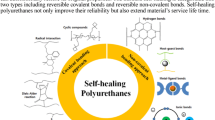Abstract
The effects of time-dependent morphology changes on the photochemical degradation efficiencies of polymers were investigated using the segmented polyurethane 1. A segmented polyurethane was chosen for this study because segmented polyurethanes have distinct hard (crystalline) and soft (amorphous) morphologies in the solid-state. It is known that, as these polymers cure, the hard and soft domains expand in the days and weeks following preparation. Experiments showed that the quantum yields for degradation of thin films of polymer 1 decreased over a period of about 30 days following preparation of the polymer films. Infrared spectroscopy showed an increase in crystallinity in the polymer during this curing period. These results are consistent with the hypothesis that the rate of photodegradation in polymer systems is controlled by the separation rate of the photogenerated radical pair relative to the rate of radical-radical recombination (Scheme 3). An important factor that controls the ratio of these two rates is the crystallinity of the polymer; an increase in crystallinity favors the radical-radical recombination reaction. The effect of tensile stress on photodegradation efficiencies was also studied. Two samples of the same polymer, one more crystalline than the other, were examined. The quantum yields for degradation of the more crystalline sample were less affected by tensile stress than the less crystalline sample. Tensile stress is known to order polymer chains and the results are again interpreted as being consistent with the idea that crystallinity is an important factor in controlling the efficiency of polymer photodegradation.









Similar content being viewed by others

Notes
The starting values of Amax were set to 1, νmax was approximated from the spectra, and FWHM was approximated to be 20 cm−1. Subsequent starting values were approximated from the initial fit.
References
D.R. Tyler, Coord. Chem. Rev. 246, 291 (2003)
B.C. Daglen, D.R. Tyler, ACS Symp. Ser. 939, 384 (2006)
R. Chen, M. Yoon, A. Smalley et al., J. Am. Chem. Soc. 126, 3054 (2004)
B.C. Daglen, J.D. Harris, D.R. Tyler, J. Inorg. Organomet. Polym. Mater. 17, 267 (2007)
S.C. Tenhaeff, D.R. Tyler, Organometallics 10, 1116 (1991)
S.C. Tenhaeff, D.R. Tyler, Organometallics 10, 473 (1991)
S.C. Tenhaeff, D.R. Tyler, Organometallics 11, 1466 (1992)
C. Hepburn, Polyurethane Elastomers (Elsevier Science Publishers, London, 1992)
G.L. Wilkes, S. Bagrodia, W. Humphries et al., J. Polym. Sci. Polym. Lett. Ed. 13, 321 (1975)
J.R. White, N.Y. Rapoport, Trends Polym Sci (Cambridge, United Kingdom) 2, 197 (1994)
R. Chen, D.R. Tyler, Macromolecules 37, 5430 (2004)
R. Chen, D.R. Tyler, ACS Symp. Ser. 928, 429 (2006)
J.A. De Haseth, J.E. Andrews, J.V. McClusky et al., Appl. Spectrosc. 47, 173 (1993)
A.M. Heintz, D.J. Duffy, C.M. Nelson et al., Macromolecules 38, 9192 (2005)
M.J. Elwell, A.J. Ryan, H.J.M. Grunbauer et al., Polymer 37, 1353 (1996)
J.P. Sheth, D.B. Klinedinst, T.W. Pechar et al., Macromolecules 38, 10074 (2005)
J.M. Vandenbelt, C. Henrich, Appl. Spectrosc. 7, 171 (1953)
Spectral Database for Organic Compounds SDBS Page. http://riodb01.ibase.aist.go.jp/sdbs/cgi-bin/direct_frame_top.cgi. Accessed Jul 2008
J.L. McHale, Molecular Spectroscopy (Prentice Hall, Upper Saddle River, New Jersey, 1999)
G.C.M. Pimentel, A.L. McCellan, The Hydrogen Bond (W. H. Freeman & Co., San Francisco, 1960)
S. Krimm, V.L. Folt, J.J. Shipman et al., J. Poly. Sci. Pt. A 1, 2621 (1963)
M. Tasumi, T. Shimauouchi, Spectrochimica Acta 17, 731 (1961)
Acknowledgments
Acknowledgment is made to the Petroleum Research Fund, administered by the American Chemical Society, and to the National Science Foundation (CHE-0452004) for the support of this research.
Author information
Authors and Affiliations
Corresponding author
Rights and permissions
About this article
Cite this article
Daglen, B.C., Tyler, D.R. The Effect of Morphology Changes on Polymer Photodegradation Efficiencies: A Study of Time-Dependent Morphology and Stress-Induced Crystallinity. J Inorg Organomet Polym 19, 91–97 (2009). https://doi.org/10.1007/s10904-009-9252-1
Received:
Accepted:
Published:
Issue Date:
DOI: https://doi.org/10.1007/s10904-009-9252-1



